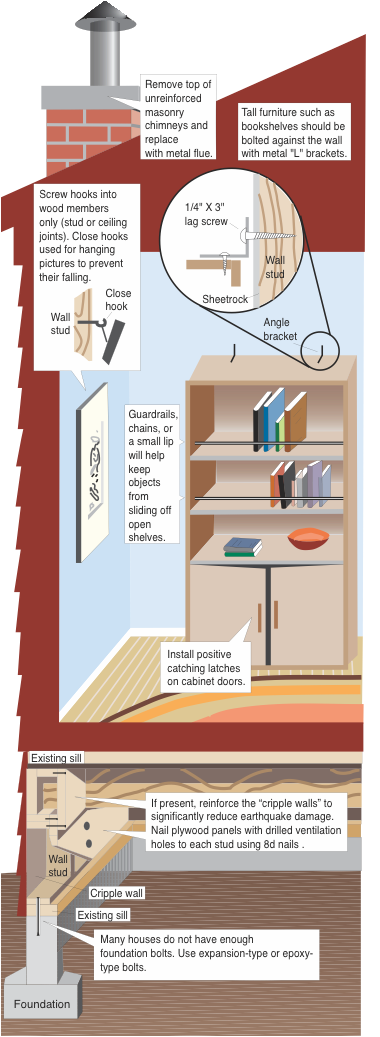No matter where you live in Alaska, you should take steps to prepare for a damaging earthquake. Talk to your family and make an earthquake plan. Take a few simple steps to protect your home and make it safer. Get the supplies you might need in the aftermath, especially if the earthquake happens during the winter.
Plan and practice
It is important to have a plan in place before an earthquake happens and to practice each step of that plan, from the moment the shaking starts:
- Practice "drop, cover, and hold on."
- Know your tsunami evacuation route.
- Identify the safest places to take shelter, away from heavy furniture, windows and mirrors, bookshelves, etc.
- Select a safe place for your family to meet after an earthquake along with an alternative location.
- Designate an out-of-the-area telephone contact, a friend or relative, to receive information about your family. All family members should carry this phone number at all times.
- Make sure every family member knows how to turn off the gas in your home. Keep an appropriate wrench near the valve at all times.
- Talk to your children's school about their disaster policy.
- Arrange with neighbors to watch out for your family and property in case you are not at home.
Prepare your home or workplace
Falling objects and toppling furniture present the greatest danger and potential loss for most people. Building contents should be secured:
- Fasten your water heater to wall studs.
- Connect all gas heaters and appliances to the gas pipe using flexible tubing.
- If you use propane or heating oil, be sure the storage tank is secured against overturning and sliding.
- Secure your woodstove to wall or floor studs. Make sure you have a fire extinguisher close at hand.
- Be sure that no heavy items such as pictures or mirrors can fall on your bed.
- Secure tall furniture and bookcases to the wall.
- Add lips to shelves to prevent costly items from sliding off.
- Put strong latches on cabinet doors.
- Fasten heavy or precious items to shelves or tables.
- Secure file cabinets, computers, televisions, and machinery.
- Store potentially hazardous materials in sturdy cabinets that are fastened to the wall or floor.
- Ask a carpenter or electrician to check light fixtures and modular ceiling systems.
- Many specialty earthquake fasteners are commercially produced. Check with your hardware store, search the Internet for products or ask your local emergency management office for suggestions.
- Review our earthquake preparedness booklet for details and diagrams.
Emergency supplies
Keep enough supplies to meet your needs for at least seven days. Store these items in sturdy, portable containers such as backpacks or totes. These are the basics for any emergency:
- Flashlights with spare batteries
- Crank or battery-operated radio
- First aid kit
- Fire extinguisher
- Week's supply of non-perishable food and juice
- 3 gallons of water per person
- Clothes, blankets and sleeping bags for subzero weather
- Medication
- Tools, especially for turning off gas and water

Return to Are You Prepared.






